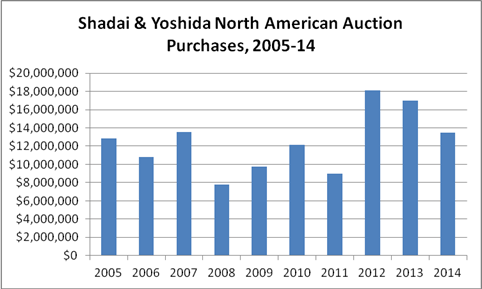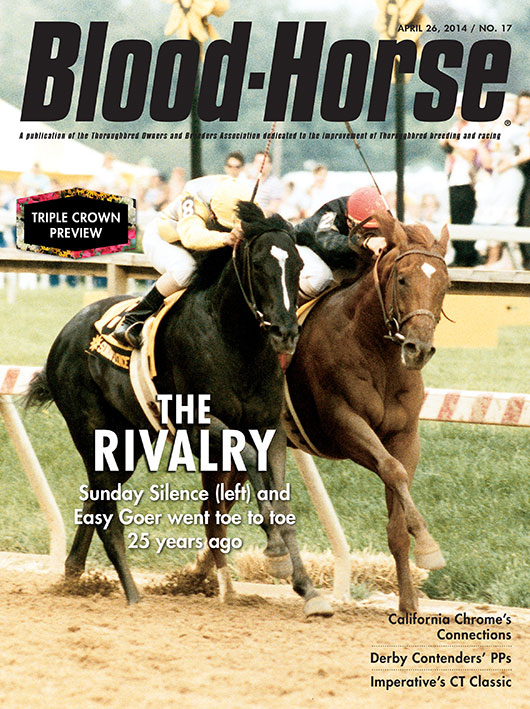In the past several years there seems to be a noticeably large spike in interest of how U.S. horses are moving around the globe, especially online. I have read more comments and discussions on horse racing or breeding abroad in 2014 than any other year in memory. Summer Bird and I'll Have Another setting sail for Japan seem to be specific marks on the calendar where I first observed a significant dialog increase. Aside from the breeding world, the subject of aftercare, such as Old Friends' partnerships with international organizations, also furthered these discussions.
These online discussions made me wonder if there was a way to determine whether the rate of U.S. horses being bought by international interests has increased, and what might be contributing to that increase. How much, if anything, has really changed in the past 10 years regarding U.S. horses being sold overseas? Focusing on Japan specifically, has Japan begun buying more horses in the past five years than in previous history? Does Japan value on-track performance more than other factors such as pedigree? How does that translate to how horses are sold? Each of these questions contain a piece in the puzzle of 'Are more horses shipping to new homes in Japan?'
Part of the perceived increase in business with Japan and other countries may boil down to communication. The telecommunications growth allows greater access to readily-available data, timely news, and rise of social media. This makes information on these bloodstock transactions easier for fans and observers to monitor and discuss.
SHINAR: Japan's Calling, but is America Listening?
This also highlights another possible change: Breeders and buyers are more open to discuss the transactions and movement of their horses because tools and platforms such as social media make it easy to do so.
Ian Tapp, managing editor of Blood-Horse MarketWatch, says, "I suspect that Japan's buying of top U.S. bloodstock is about the same as recent years, but because of the increased flow of information via the Internet and social media, each transaction gets more publicized."
With more visibility and information available, we can better look at trends from sales.
Below is a graph that reveals combined averages of purchases each year at North American auctions since 2005 for Shadai Farm and the Yoshida family—the powerhouses of Japan's breeding industry.

MACDONALD: Looking Inside Yoshida's 'Jewel Box'
Tapp also said selection criteria that the U.S. market may find valuable or fashionable can create opportunities for Japanese buyers willing to buy a top racehorse without a flashy pedigree or exceptional looks.
Sunday Silence is the poster child for such an opportunity. He had proven excellence on the track but upon his retirement was met with skepticism from U.S. breeders due his physical appearance and less-than-fashionable pedigree. The Japanese took a chance on an exceptional racehorse and the rest is history—Sunday Silence revolutionized Japan's Thoroughbred industry.

Order This Cover
The acquisition and success of Sunday Silence reinforced Japan's confidence in purchasing top classic-type racehorses without worrying too much about pedigree and physique.
I’ll Have Another and Summer Bird are two recent stallion examples. Summer Bird was a champion 3-year-old son of Birdstone best at 10-12 furlongs. I'll Have Another, also a champion at 3, was best at 9-10 furlongs and didn't have a particularly exciting pedigree for the U.S. market. Consequently, both fit a similar profile to Sunday Silence and were sold to Japan.
If we look at the horses sold to Japan in the past few years, even those bought from other international markets such as Australia and Europe, the pedigree and ability to run classic distances are bought when the deal is ripe. Not to dismiss the value placed on pedigree or conformation, but the vast majority of Japan's major purchases involve horses with a great degree of success on the racetrack.
In closing, Japan's buying habits are nothing new. The focus of Japan's breeding industry is to continue building on their success; their desired criteria are racetrack-tested stallions and high-quality broodmares. In conclusion, I do not see evidence to support an increase in the number of horses sold, just a consistent commitment to quality, performance, and classic-oriented runners. In Japan, space is limited and expectations are high. That consistency and criteria has built the competitive industry that now exists in Japan, and has in return brought interest in Japanese horses to other racing jurisdictions and breeding industries, including the U.S. and Europe.
Further information: You can search and find complete sales history in our online auctions tool: http://www.bloodhorse.com/horse-racing/thoroughbred-sales
On the mentioned auctions database, searching a specific year with either "yoshida" or "shadai," you can find more insight into what horses were bought. Mostly the broodmares. You will also be able to note the on track success of most purchases.
The following list was originally omitted from the blog post and may help for specific examples and mare purchases. Here is what was originally cut; a sample of notable mares and stallions sold in the past five years compared to ten years ago.




